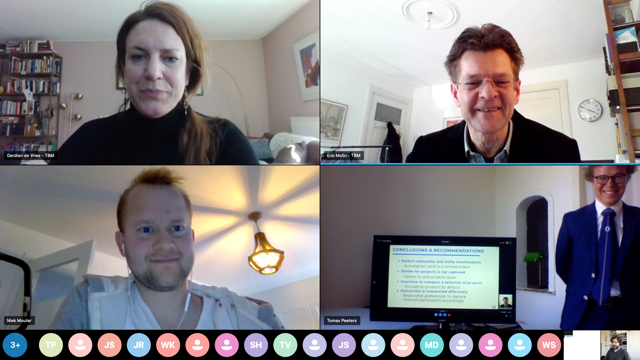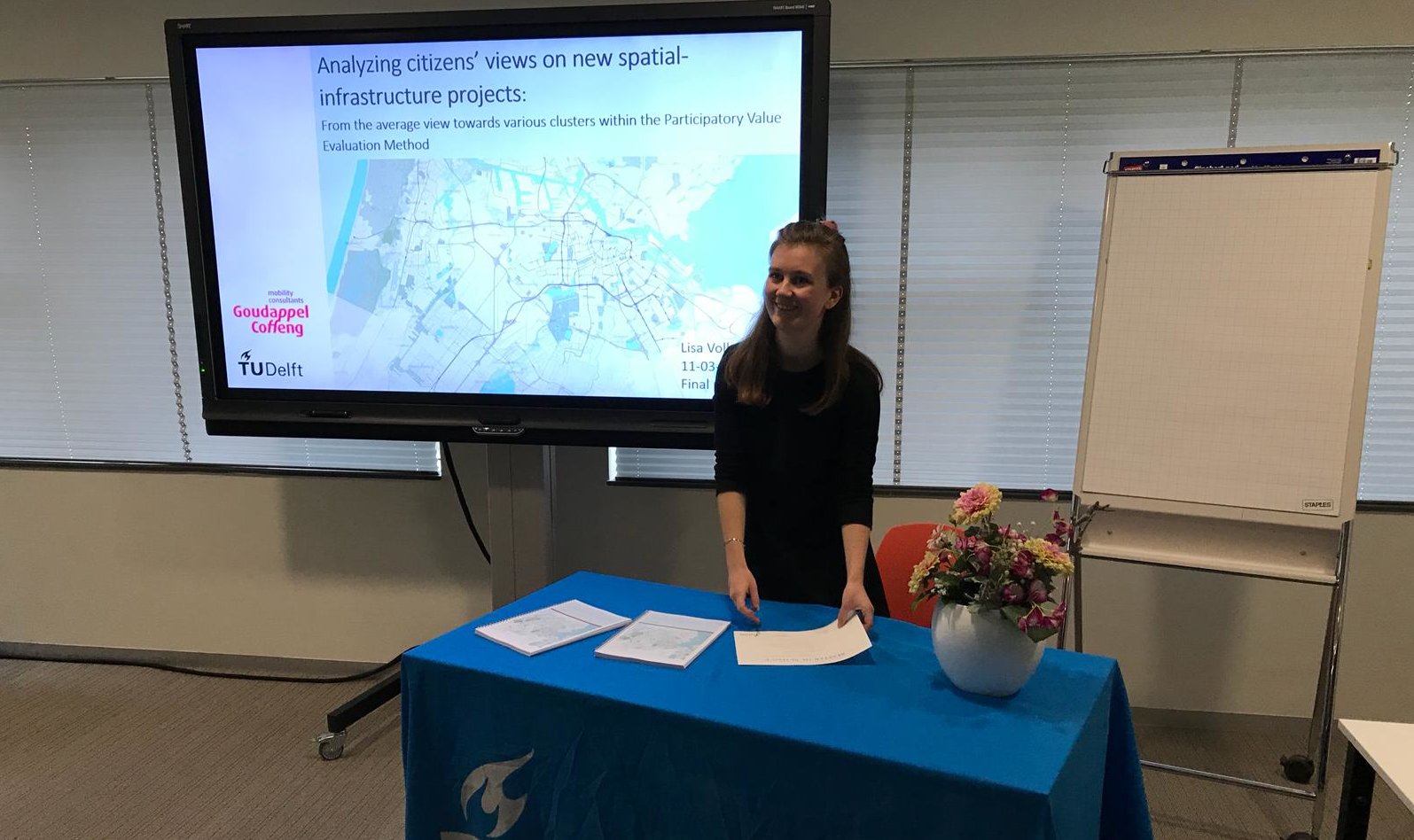Finished student projects
PVE for inner-city area developments
Student: Jan Bruinink
How useful is PVE for inner-city area developments? This was the central question for the thesis of Jan Bruinink, Master student Human Geography at Utrecht University. To investigate this, the concept of usability first had to be operationalized. The 'human-computer interaction' discipline provides tools for assessing web-based participatory planning support systems such as PVE on their usability. Assessment criteria regarding the usefulness of the method and user-friendliness for the respondents were central to the assessment of the usability of PVE.
By assessing the usefulness of the method, a number of points for attention have emerged that must be taken into account during the design of a PVE. With this, the step-by-step plan for the design of a PVE by Sophie Pak (2018) has been supplemented. A PVE was set up for the case study with the help of this adapted step-by-step plan. Despite the layout, it appears to be difficult to gain insight into the respondents' decision-making process; additional qualitative research is more suitable for this.
Ultimately it was concluded that the functionalities of PVE do not stand in the way of effective participation, provided the modified step-by-step plan is followed. The case study respondents gave the highest score for user-friendliness, performance criteria, connectivity, learnability, and margin of error. Effectiveness received the lowest score. The respondents appeared to have a varied view of the method, indicated by high standard deviations. An experiment with a larger response can provide better insight into how PWE scores on the 8 facets of user-friendliness of web-based participatory planning support systems.
It can be concluded that, under certain conditions, PVE can be an excellent method for organizing the participation process of an inner-city area development. It is therefore recommended to apply the method to a concrete case study. This was not possible for this thesis due to the consequences of the coronavirus. In addition, the method also appears to be ideally suited to the problem of the fictional case study; further research into this can yield extremely interesting results.
The appropriateness of PVE for Encompassing (Feelings of) Safety (and Security) in Public Transport
Students: Roy Rizk & Shahin Farshchi (KTH)
In this study, Roy Rizk and Shahin Farshchi took an explorative approach in testing the PVE design in an area where qualitative aspects are highly important. By collecting responses for a pilot PVE and analysing the design and method, they set out to answer if the qualities of the design of a PVE can help encompass feelings of safety and security. The study was conducted in Stockholm at the Royal Institute of Technology. Roy and Shahin worked at different faculties during the thesis, making the work an interdisciplinary collaboration between the departments of Urban and Regional Studies and System Analysis and Economics.
For developing knowledge in the feelings of safety and security context today, participatory descriptive assessments hold a strong position. However, there exists a methodological gap between the participatory descriptive tradition and the quantitative impact tradition. Filling the methodological gap that exists can be vital in moving methods closer to public and policy demands and norms. By using in depth descriptive information as PVE input, the study aims to provide a methodological contribution by analysing the PVE method in a new complex setting with modifications made.
Descriptive results from the PVE method is regarded to still advance knowledge on feelings of safety and security, while improving the impact focus of appraisals by evaluating projects. The method can benefit from a focus on transparency, attractive participation and quality in results and the amendment here called ‘re-categorisation’ was found necessary for PVE appraisals. Incentives to keep flawed processes can be found in political and policy realms and with no actor controlling the intersectoral (and interdisciplinary) issue of feelings of safety and security, traditions can have a strong impact. However, this study shows feasibility in improving appraisals given the contemporary public and policy standards.
Information provision on complex subjects in a PVE
Student: Sem Nouws
How to provide information about complex subjects to participants in PVE? Sem Nouws, student of the master Complex Systems Engineering and Management, studied different information provision approaches in a PVE on urban climate adaptation for his master thesis project. He observed that participants’ wants and needs regarding information are very divergent.
Information provision on complex subjects such as urban climate adaptation in participation often falls short. Participants often only have limited prior knowledge on the subject or do not have the experience or skills to process the information. On the other hand, policy makers or other facilitators of participation do not select the right information, present it in the wrong way or use the information provision strategically. With PVE it is possible to give participants the right insights in complex subjects. However, also the information provision in this new participation method can be improved. Therefore, Sem searched for possibilities to provide complex information in PVE.
In his research, Sem tested two information provision approaches in a PVE-survey on the realization of a water storage in Reyeroord, a neighbourhood in Rotterdam. Half of the respondents received extra information on climate change, the need for climate adaptation and the technicalities of adaptation measures. The other respondents received images that visualized the different policy options. The participants were asked to assess the quality of the information provision and whether they felt empowered by the information to give informed input or to make a choice between the policy options.
The two tested information provision approaches do not lead to a different evaluation by participants, however, visualizations appear to be of importance. But the most remarkable result was that the wants and needs for information provision by participants are very heterogeneous. This is because of the diverse backgrounds and characteristics (socio-demographic characteristics, attitudes, experiences) of participants. Therefore, it is better to adapt the information provision in PVE to the different wants and needs of participants.
Coherence between perspectives and preferences in a PVE
Student: Elisa de Weerd
Preferences can be measured in different ways. It is unclear to what extent the findings of those methods are coherent. During her internship at RIVM (National Institute for Public Health and the Environment), Elisa de Weerd, student of the Research Master Health Sciences at the Erasmus University Rotterdam, researched the relation between two methods for measuring preferences: the Q methodology and Participatory Value Evaluation (PVE). The Q methodology is a method to investigate what kind of perspectives are held on a certain topic within a population.
The preferences Elisa studied in her thesis were about health care: what do people find important in decisions about reducing the basic health care package? Participants in the PVE were asked to cut 100 million euros by removing various medical treatments from the basic health care package. Thereafter participants indicated to what extent they agreed with the perspectives from an earlier Q methodology study.
Elisa investigated whether the answers to the perspectives related to the preferences in the PVE, based on a subgroup analysis. Ideally, this was investigated using a latent class analysis, but unfortunately this was not yet possible due to the complexity of the design of the PVE.
Several differences were found, but these did not match the hypotheses. This suggests that the differences were drive by other factors. Although it is not possible to provide an unambiguous answer to the research question, it can be concluded that the research methods do not replace each other. For example, Q methodology is a suitable method when little is known about preferences, whereas PVE is more suitable to investigate the trade-offs between different aspects of preferences when more is known about the preferences themselves. It is therefore important for policymakers to determine which method is most suitable for measuring preferences, on the basis of existing knowledge.
How do participants make choices in a PVE?
Student: Tomas Peeters
How do participants in Participatory Value Evaluation (PVE) experiments come to their decisions and what do they base their choice on? And does the presentation of the impact of projects by means of text or figures influence that choice? This was investigated by Tomas Peeters, student of the master Complex Systems Engineering and Management, who defended his thesis on 31 March 2020. The defense took place entirely online because of the Corona crisis.
To answer these questions, Tomas set up a relatively small-scale PVE experiment about six infrastructure projects within the municipality of Delft. A so-called Process Tracing study was carried out with this. Ten participants were asked to go through the PVE as they spoke their thoughts out loud, and their interaction with the online environment was recorded. This showed that several participants early in the selection process disregarded projects based on a first impression without studying all the information. Such aversion to a project is currently not specifically measured. Participants also interpreted the instruction differently and wondered what they should base their choice on: purely on the information given or also on their own experience or preferences?
In a subsequent variation experiment, two versions of the PVE experiment were prepared in which the impact of projects were presented in text or figures. These were completed by 85 and 84 participants, respectively. The results show that the influence of the variation on participants' choices is limited.
Based on the results, it is recommended to give participants the option to vote against projects. It is also recommended for policy makers and PVE developers to determine which preferences they want to measure and adapt the instruction to participants accordingly.
The influence of residential location in PVE
Student: Lisa Volberda
Are people influenced by the location they life when participating in a PVE for transport projects? Lisa Volberda concluded her thesis around this topic, and concluded that the answer to this question is yes. In her thesis, she identified the distribution of citizens for the allocation of the public budget towards spatial- infrastructure projects, by making use of Participatory Value Evaluation (PVE).
For her thesis, Lisa made use of the dataset of a PVE experiment in the Region of Amsterdam (Vervoerregio Amsterdam). A Latent Class Cluster Analysis model was estimated to identify citizens selecting a similar combination of spatial-infrastructure projects. The results of her study found that individuals are more likely to select projects in their living area. Furthermore, individuals prefer rather a higher number of projects having low costs than one expensive project, and individuals assign high values to safety compliance projects. The results indicate that individuals do neither necessarily base their choice on quantitative attribute values, such as minutes of travel time reduction realized by a new project, nor do individuals select a combination of projects based on improvements realized by these projects for a specific travel mode. By doing experts’ interviews, this study also provides a rich reflection of the implications of the clusters identified. The desirability of the location-effect depends on the aim of the experiment. The main implication of the results is that researchers have to be aware of the strong location-effect and that future research should control for this effect.



